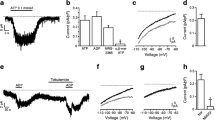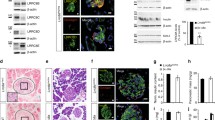Abstract
Adrenaline and somatostatin inhibit insulin secretion via pertussis toxin (PTX)-sensitive mechanisms. Since glucose-stimulated release involves inhibition of ATP-sensitive K+ (K +atp ) channels and activation of Ca2+ influx, we took advantage of the glucose-sensitive, insulin-secreting cell line INS-1 to investigate whether inhibitors of insulin release modulate membrane voltage and K +atp channel activity in cellattached patch-clamp experiments. We found that adrenaline, through β2-adrenoceptors, and somatostatin counteracted glucose-induced depolarization and action potentials. As expected, these effects were mediated via PTX-sensitive G proteins since PTX pretreatment of the cells eliminated the effects of adrenaline and somatostatin on membrane voltage. When INS-1 cells were activated by adding both the K +atp channel inhibitor tolbutamide and the adenylyl cyclase activator forskolin, adrenaline and somatostatin still repolarized the plasma membrane. Single-channel measurements in the cell-attached mode revealed that tolbutamide closed a 40 to 70 pS K+ channel which was neither reopened by adrenaline nor by somatostatin. In parallel cell preparations, insulin secretion was measured by radioimmunoassay. Insulin release induced by glucose, forskolin and tolbutamide was abolished by adrenaline. In contrast, somatostatin attenuated insulin secretion by only 30%. After comparing the potency of adrenaline and somatostatin on membrane voltage and on insulin secretion, it is concluded that the repolarizing effect of adrenaline on membrane voltage is not sufficient to explain its potent inhibitory effect on insulin secretion.
Similar content being viewed by others
References
Aguilar-Bryan L, Nichols CG, Wechsler SW, Clement JP IV, Boyd AE III. Gonzalez G. Herrera-Sosa H, Nguy K, Bryan J, Nelson DA (1995) Cloning of the ² cell high-affinity sulfonyl- urea receptor: a regulator of insulin secretion. Science 268:423–426
Amiranoff B, Lorinet AM. Lagny-Pourmir I, Laburthe M (1988) Mechanism of galanin-inhibited insulin release. Eur J Biochem 177:147–152
Asfari M, Janjic D. Meda P, Li G. Halban PA, Wollheim CB (1992) Establishment of 2-mercaptoethanol-dependent differentiated insulin-secreting cell lines. Endocrinology 130:167–178
Ashcroft SJH, Ashcroft FM (1990) Properties and functions of ATP-sensitive K+-channels. Cell Signal 2:197–214
Bokvist K, Eliasson L, Ämmälä C, Renström E, Rorsman P (1995) Co-localisation of L-type Ca2+ channels and insulin-containing secretory granules and its significance for the initiation of exocytosis in mouse pancreatic B-cells. EMBO J 14:50–57
Chan SLF, Morgan NG (1995) Molecular analysis of β2-adreno- ceptor gene expression in rat pancreatic A-and B-cells. Diabetologia 38: Al30
Cook DL, Hales CN (1984) Intracellular ATP directly blocks K+-channels in pancreatic β-cells. Nature 311:269–271
Debuyser A, Drews G, Henquin JC (1991) Adrenaline inhibition of insulin release: role of the repolarization of the B cell membrane. Pflügers Arch 419:131–137
Dunne MJ, Bullett MJ, Li GD, Wollheim CB, Petersen OH (1989) Galanin activates nucleotide-dependent K+ channels in insulin-secreting cells via a pertussis toxin-sensitive G-protein. EMBO J 8:413–420
Henquin JC, Meissner HP (1984) Significance of ionic fluxes and changes in membrane potential for stimulus-secretion coupling in pancreatic β-cells. Experientia 40:1043–1052
Herbert V, Lau KS, Gottlieb CW, Bleicher SJ (1965) Coated charcoal immunoassay of insulin. J Clin Endocrinol Metab 25:1375–1384
Homaidan FR, Sharp GWG, Nowak LM(1991) Galanin inhibits a dihydropyridine-sensitive Ca2+ current in the RINm5F cell line. Proc Natl Acad Sci USA 88:8744–8748
Hsu WH, Xiang H, Rajan AS, Kunze DL, Boyd AE III (1991) Somatostatin inhibits insulin secretion by a G-protein-mediated decrease in Ca2+ entry through voltage-dependent Ca2+ channels in the beta cell. J Biol Chem 266:837–843
Katada T. Ui M (1981) Islet-activating protein. A modifier of receptor mediated regulation of rat islet adenylate cyclase. J Biol Chem 256:8310–8317
Kerst G. Fischer KG, Normann C, Kramer A, Leipziger J, Greger R(1995) Ca2+ influx induced by store release and cytosolic Ca2+ chelation in HT29 colonic carcinoma cells. Pflügers Arch 430:653–665
Konrad RJ, Young RA, Record RD, Smith RM, Butkerait P, Manning D, Jarett L, Wolf BA (1995) The heterotrimeric G- protein Gi is localized to the insulin secretory granules of the β-cells and is involved in insulin exocytosis. J Biol Chem 270:12869–12876
Lang J, Nishimoto I, Okamoto T, Regazzi R, Kiraly C, Weiler U, Wollheim CB (1995) Direct control of exocytosis by receptor-mediated activation of the heterotrimeric GTPases Gi and G0 or by the expression of their active Gx subunits. EMBO J 14:3635 3644
Morgan NG, Montague W(1985) Studies on the mechanism of inhibition of glucose-stimulated insulin secretion by noradrenaline in rat islets of Langerhans. Biochem J 226: 571–576
Nilsson T, Arkhammar P, Rorsman P, Berggren PO(1988) Inhibition of glucose-stimulated insulin release by β2-adrenoceptor activation is paralleled by both a repolarization and a reduction in cytoplasmic free Ca2+ concentration. J Biol Chem 263:1855–1860
Nilsson T, Arkhammar P, Rorsman P, Berggren PO(1989) Suppression of insulin release by galanin and somatostatin is mediated by a G-protein. J Biol Chem 264:973–980
Prentki M, Matschinsky FM (1987) Ca2+, cAMP and phospholipid-derived messengers in coupling mechanisms of insulin secretion. Physiol Rev 67:1185–1249
Reaven GM (1995) Pathophysiology of insulin resistance in human disease. Physiol Rev 75:473–486
Ribalet B, Eddlestone GT (1995) Characterization of the G protein coupling of a somatostatin receptor to the K +atp channel in insulin-secreting mammalian HIT and RIN cell lines. J Physiol (Lond) 485:73–86
Rorsman P, Bokvist K, Ämmälä C, Arkhammar P, Berggren PO, Larsson O, Wahlander K (1991) Activation by adrenaline of a low-conductance G protein-dependent K+ channel in mouse pancreatic B cells. Nature 349:77–79
Santana de Sa S, Ferrer R, Rojas E, Atwater I (1983) Effects of adrenaline and noradrenaline on glucose-induced electrical activity of mouse pancreatic β-cell. Q J Exp Physiol 68:247–258
Schmid-Antomarchi H, De Weille J, Fosset M, Lazdunski M (1987) The receptor for antidiabetic sulfonylureas controls the activity of the ATP-modulated K+ channel in insulin-secreting cells. J Biol Chem 262:15840–15844
Schmidt A, Hescheler J, Oftermanns S, Spicher K, Hinsch KD, Klinz FJ, Codina J, Birnbaumer L, Gausepohl H, Frank R, Schultz G, Rosenthal W (1991) Involvement of pertussis toxin- sensitive G-proteins in the hormonal inhibition of dihydropyridine-sensitive Ca2+ currents in an insulin-secreting cell line (RINm5F). J Biol Chem 266:18025–18033
Seaquist ER, Robertson Neal A, Shoger KD, Walseth TF, Robertson RP (1992) G-proteins and hormonal inhibition of insulin secretion from HIT-T15 cells and isolated rat islets. Diabetes 41:1390–1399
Ullrich S, Wollheim CB (1984) Islet cyclic AMP levels are not lowered during β2-adrenergic inhibition of insulin release. Studies with epinephrine and forskolin. J Biol Chem 259:4111–4115
Ullrich S, Wollheim CB (1988) GTP-dependent inhibition of insulin secretion by epinephrine in permeabilized RINm5F cells. Lack of correlation between insulin secretion and cyclic AMP levels. J Biol Chem 263:8615–8620
Ullrich S, Wollheim CB (1989) Galanin inhibits insulin secretion by direct interference with exocytosis. FEBS Lett 247: 401–404
Ullrich S, Prentki M, Wollheim CB (1990) Somatostatin inhibition of Ca2+-induced insulin secretion in permeabilized HIT- T15 cells. Biochem J 270:273–276
Weille JR De, Schmid-Antomarchi H, Fosset M, Lazdunski M (1988) ATP-sensitive K+ channels that are blocked by hypoglycemia-inducing sulfonylureas in insulin-secreting cells are activated by galanin, hyperglycemia inducing hormone. Proc Natl Acad Sci USA 85:1312–1316
Weille JR De, Schmid-Antomarchi H, Fosset M, Lazdunski M (1989) Regulation of ATP-sensitive K+ channels in insulinoma cells: activation by somatostatin and protein kinase C and the role of cAMP. Proc Natl Acad Sci USA 86:2971–2975
Author information
Authors and Affiliations
Rights and permissions
About this article
Cite this article
Abel, KB., Lehr, S. & Ullrich, S. Adrenaline-, not somatostatin-induced hyperpolarization is accompanied by a sustained inhibition of insulin secretion in INS-1 cells. Activation of sulphonylurea K +ATP channels is not involved. Pflügers Arch — Eur J Physiol 432, 89–96 (1996). https://doi.org/10.1007/s004240050109
Received:
Revised:
Accepted:
Issue Date:
DOI: https://doi.org/10.1007/s004240050109




